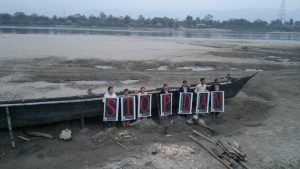The Indian government has swung into action within hours of a news report in a state run daily in China that a jumbo hydropower project will be built in Tibet.
On December 1, a senior Indian government official was quoted by the media in New Delhi as saying that plans are on to build a 10-gigawatt hydroelectric dam in the country’s northeastern state of Arunachal Pradesh, which shares a border with China. He pointed out that the “proposal” was being considered at the highest level of the government.
A week later, officials of the state-owned National Hydroelectric Power Corporation (NHPC) disclosed that a separate 2000-megawatt dam on the Subansiri River in the border state was on track to be commissioned by March 2022. The announcement comes after delays that have led to an escalation of the project cost from 69 billion to 200 billion Indian rupees (around $2.7 billion). The project in China, which has been slated for construction on the Yarlung Tsangpo river in Tibet’s Medog county, will generate 60 gigawatts of electricity capacity and will surpass the country’s Three Gorges Dam in terms of capacity.
The Yarlung Tsangpo (also called Yarlung Zangbo) is the highest altitude river in the world, and flows through Arunachal Pradesh in India’s northeast before joining the Brahmaputra River. Concerns have been raised over the possibility of hazards and loss of livelihood in the downstream region of India’s northeast after the project is completed.
The Indian government sees its northeastern region, which comprises eight border states, as the country’s “future powerhouse.” In 2001, the Central Electricity Authority (CEA) identified 168 large hydroelectric projects with a potential of 63,328 megawatts in the Brahmaputra River basin. The surface water resource of the region is around 652.3 billion cubic meters, comprising 34 percent of the country’s total water wealth, according to a report compiled by the government.
However, the region is also a biodiversity hotspot, prone to crises and geologically fragile besides being politically sensitive. Assam has been the worst affected among all the states and particularly devastated at regular intervals by flood and erosion over the past several decades, problems which the government has been unable to tackle.
The Indian government is of the opinion that the hydropower projects in the region would contribute towards mitigating floods besides providing an alternate source of clean energy. However, hydropower projects have themselves been the cause of floods in the region as evidenced from the dams on Ranganadi river in Arunachal Pradesh and Koipli at Dima Hasao in Assam. Large parts of western Assam were submerged last year, and again in 2016, after water was released from Kurichu dam in Bhutan.
As such, the government will certainly have to assuage the fears of local communities if these northeastern hydropower projects are to be expedited. The delay in commissioning the Subansiri project had been primarily due to the protests that shook Assam four years ago. The powerful All Assam Students’ Union has reiterated its demand for the halt the construction of the project.
In 2016, the border district of Tawang in Arunachal Pradesh erupted in protest against the government’s plan for hydropower projects in the region. A large number of Buddhist lamas who had taken part in the agitation were of the view that the schemes for harnessing hydropower would severely impact several religious sites in the district. Similarly, the plan to construct a dam to generate 2,288 megawatts on the Dibang River in the same state has sparked a controversy since the government had allegedly ignored environmental regulations.
Rajeev Bhattacharyya is a senior journalist in Assam.

































